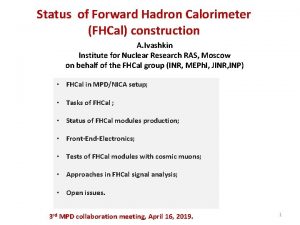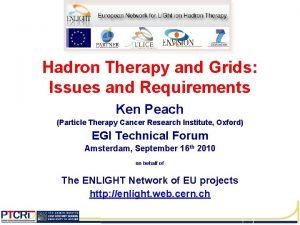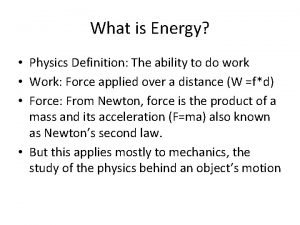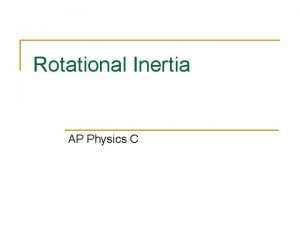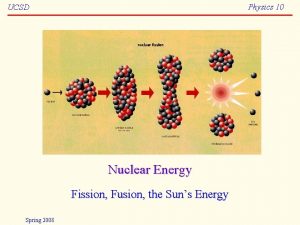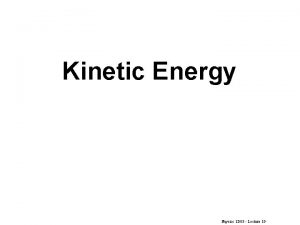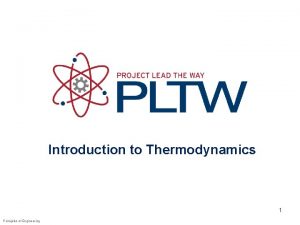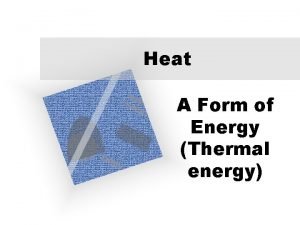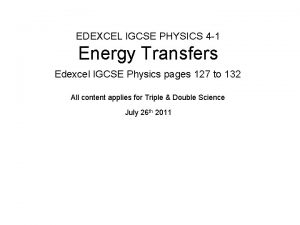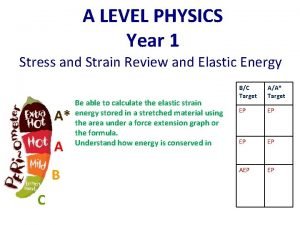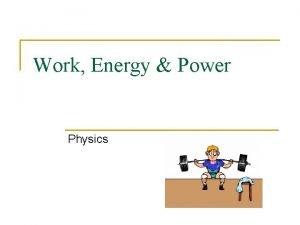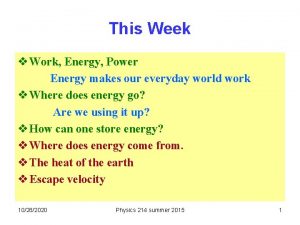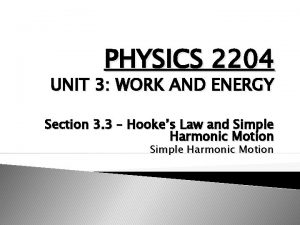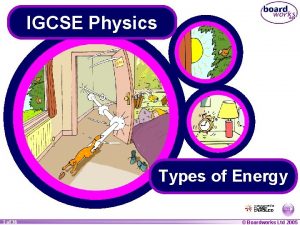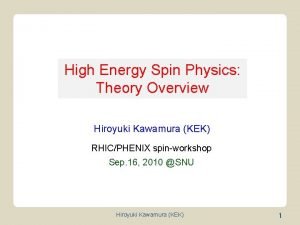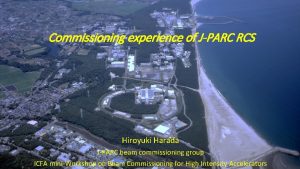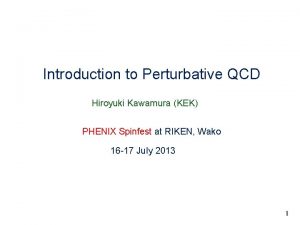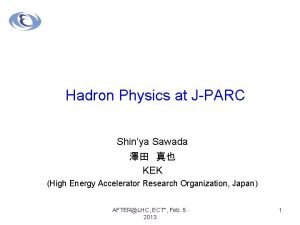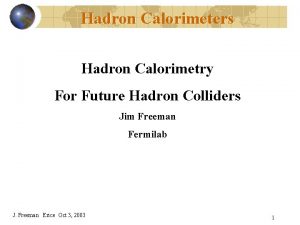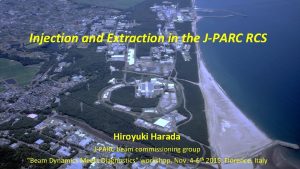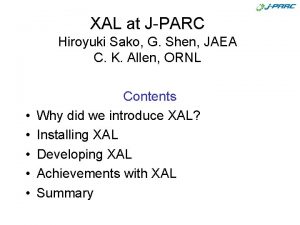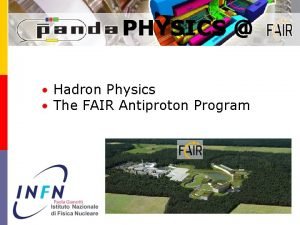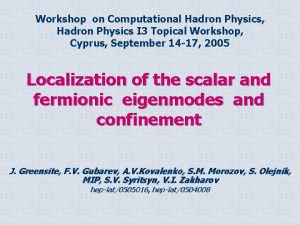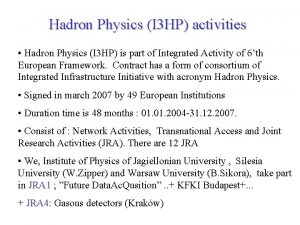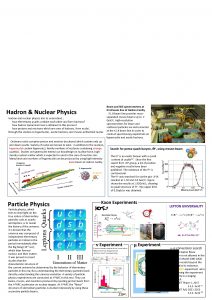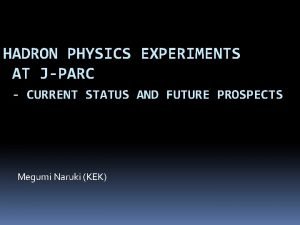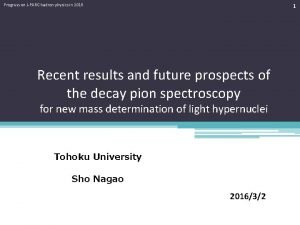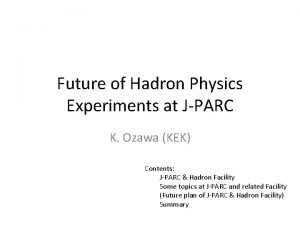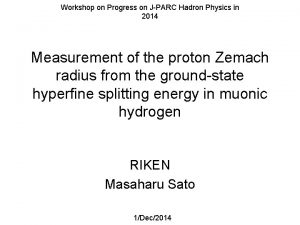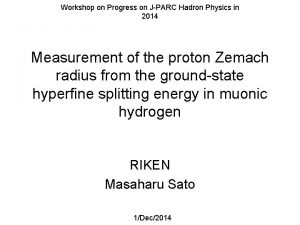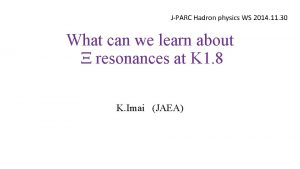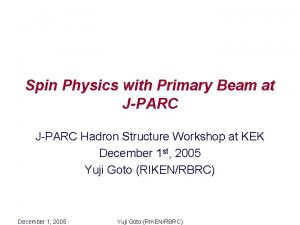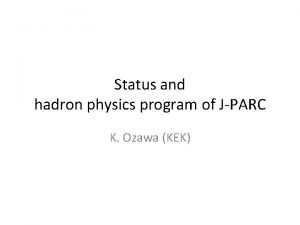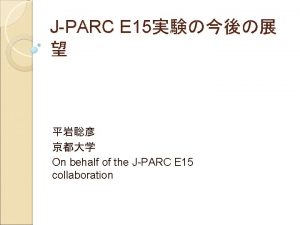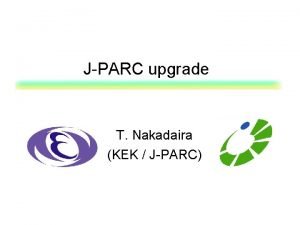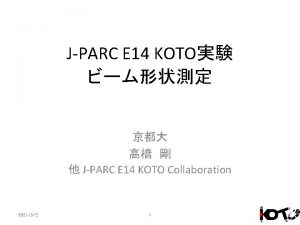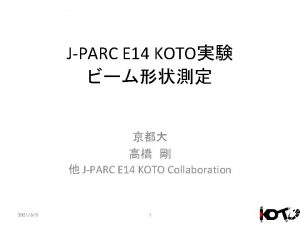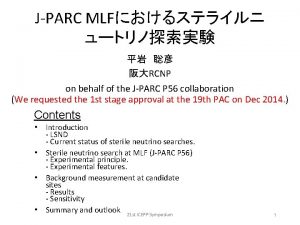High Energy Hadron Physics at JPARC Hiroyuki Kawamura

































- Slides: 33

High Energy Hadron Physics at J-PARC Hiroyuki Kawamura (KEK) Feb. 13 2014, KEK Tokai Campus Meeting on High-energy hadron physics at J-PARC

High momentum beam line at J-PARC • Primary beam Hadron Facility at J-PARC E = 30 Ge. V (→ 50 Ge. V? ) proton • Secondary beam E = 15 -20 Ge. V pion p, π p, d, A Physics • meson mass modification • charmed hadron spectroscopy • lepton flavor violation • hard processes 2

Hard Processes • PQCD — Perturbation is applicable for the short-distance part of hard processes. ex. DIS large mom. transfer (high resolution) quarks & gluons (partons) inside hadrons — The purpose of PQCD is two-fold. 1. To learn the internal structure of hadrons. parton distribution functions, GDPs, distribution amplitudes, etc. 2. To understand the dynamics of QCD. radiative corrections, soft gluon effects, heavy quark symmetries, spin dependence, etc. 3

QCD in various scales 1 Te. V High PT jets at LHC DOF: quarks & gluons 90 Ge. V Asymptotic Freedom 10 Ge. V Perturbative QCD 3 Ge. V 1 Ge. V? 0. 2 Ge. V Confinement, χSB DOF: hadrons Effective theories, Quark model, etc. 0. 01 Ge. V J-PARC Boundary of perturbative region. → Challenge for PQCD, interplay of the soft & hard physics. 4

PANDA at FAIR 0 - 15 Ge. V anti-p beam → Physics goals have a large overlap with experiments at J-PARC. 5

Contents • Introduction • Di-lepton production • Exclusive processes • Generalized Parton Distributions, Transition Distribution Amplitudes • Large-angle exclusive reaction • Charm production • Open charm production • Charmonium production • Summery 6

Drell-Yan process hard scale Factorization formula Collins, Soper, Sterman (’ 85, ’ 88), etc. partonic cross sections Parton distribution functions (PDFs) x 1 , x 2 : momentum fraction of partons Leading Order (LO) • The formula is valid up to power corrections. + NLO +… 7

DY theory vs. data Mc. Gaughey, Moss, Peng ▲ NA 3 400 Ge. V □ E 605 800 Ge. V ○ E 772 800 Ge. V CTEQ 4 M • DY data at high energies are well-described by NLO QCD. • They are included in recent global fits of PDFs. 8

PDF uncertainty • CT 10 global analysis ar. Xiv: 1302. 6246 • Favor decomposition of sea distributions Drell-Yan cross sections pion cloud model? E 866 800 Ge. V Important for CC DIS, SIDIS, W production at RHIC & LHC etc. E 906 “Sea. Quest” 120 Ge. V 9

DY process at J-PARC • Drell-Yan process can be used to explore the PDFs at the large-x region. — At the J-PARC (pp, πp), DY mass spectrum Simulation for E 866 • The pp/pd ratio can also be measured in the large x region. 10

Pion PDFs • Valence distribution of pion DY cross section : Aicher, Shäfer, Vogelsang fit counting rule E 615 Eπ=252 Ge. V Pion DY experiment at COMPASS (√S=19 Ge. V ) is coming. 11

Dilepton QT distribution Kodaira, Shimizu, Tanaka, HK (‘ 06) • Soft gluon emission RHIC resummation of large logs Non-perturbative form factor : “intrinsic k. T” impact parameter fit to data At the J-PARC kinematics, QT distribution is sensitive to the NP form factor. Hirai, Tanaka. HK(‘ 14) 12

Dilepton angular distribution In conventional p. QCD, LO (parton model) NLO NNLO (spin ½ quark) Lam-Tung relation small and positive 13

Dilepton angular distribution NA 10 • The conventional framework of p. QCD suggests small & positive values. → new mechanism? ex. TMD factorization : parton distributions with transverse momentum k. T Boer-Mulders function correlation between k. T and transverse spin of quarks 14

Higher order corrections • Higher order corrections for DY process is known up to . Hamberg, van Neerven, Matsuura Harlander, Kilgore Large K-factor Threshold enhancement due to the steep damp of anti-quark PDFs. (mismatch of real & virtual corr. ) H. Yokoya 15

Higher order corrections • All-order resummation of threshold log corrections. Shimizu, Sterman, Yokoya, Vogelsang (‘ 05) Soft gluon emission at the partonic threshold LL, NNLL • Perturbation series seems to be convergent. • Power corrections are possibly a more serious issue. 16

Contents • Introduction • Di-lepton production • Exclusive processes • Generalized Parton Distributions, Transition Distribution Amplitudes • Large-angle exclusive reaction • Other processes • Summery 17

PQCD for exclusive processes • Pion-photon transition form factor — simplest example. light-cone distribution amplitude Gegenbauer expansion CZ BMS 18

PQCD for exclusive processes General features • Factorization formula at the amplitude level. — closely related to the hadron wave function. • Momentum scale depends on the shape of LCDA. End-point singularity → k. T factorization + Sudakov resummation • Many independent non-perturbative functions. → More detailed information of hadron structure. ex. GPDs in Deeply virtual Compton scattering. Wakamatsu-san’s talk 19

Exclusive processes at J-PARC ex. DA DA GPD Transition distribution amplitude Pire, Szymanowski ↔ pion component of proton w. f. Generalization of the light-cone DAs 20

Contents • Introduction • Di-lepton production • Exclusive processes • Generalized Parton Distributions, Transition Distribution Amplitudes • Large-angle exclusive reaction • Charm production • Open charm production • Charmonium production • Summery 21

Large angle exclusive scattering • Perturbative QCD is appilcable, when . Light-cone distribution amplitudes meson baryon — However, it is difficult to calculate the amplitude. • Too many diagrams • Most DAs are unknown. — We can still rely on general feature of the large angle scattering. • Constituent counting rule • Hadron helicity conservation 22

Large angle exclusive scattering • Constituent counting rule Brodsky and Farrar (‘ 73) Matveev, Muradian, Tavkhelidze (’ 73) gluon propagator : quark propagator: external line: • Hadron helicity consevation quark helicity conservation + S-wave dominance 23

Exclusive photoproduction at Jefferson Lab. JLab E 94 -104 Onset of counting rule JLab E 89 -012 24

Lambda & Lambda(1405) Kumano, Sekihara, HK (2013) 5 -quark 3 -quark Extrapolated from the existing data by Thomas et al. (‘ 73) 25

Contents • Introduction • Di-lepton production • Exclusive processes • Generalized Parton Distributions, Transition Distribution Amplitudes • Large-angle exclusive reaction • Charm production • Open charm production • Charmonium production • Summery 26

Open charm production Partonic cross section LO NLO QCD NLO Riedl, Schäfer, Stratmann Large K-factor Resummation 27

Open charm production Kidonakis & Vogt at DIS 2004 ar. Xiv: 0405212 PQCD (fixed order + log β resummation) vs. fixed target data pi- + P → c + cbar + X P + P → c + cbar + X Theory calculation must be improved to meet even the existing data. 28

Contents • Introduction • Di-lepton production • Exclusive processes • Generalized Parton Distributions, Transition Distribution Amplitudes • Large-angle exclusive reaction • Charm production • Open charm production • Charmonium production • Summery 29

Charmonium production • Theoretical Framework: NRQCD factorization Bodwin, Braaten, Lepage, PRD 51(1995)1125. Inclusive production of charmonium H = (c-cbar production with ) (transition: ccbar → H ) color “matrix elements” (MEs) ↔ non-perturbative (determined from experiment) color singlet Kniehl et al, NPB Suppl. XX (2012) 1. color octet 30

Charmonium production Hadro-production Cho & Leibovich PRD 53(1996)150 -162; ibid 6203 -6217, Beneke, PRD 54(1996)2005, etc. ex. J/Ѱ production in pi-N collision Beneke, PRD 54(1996)2005. Note: old values for the (LO)MEs. J-PARC data might be able to provide some information on the operator MEs. Polarization measurement is very important. 31

Pion production PHENIX data vs. NLO p. QCD NLO QCD works even at PT=1 Ge. V? A similar hard process : direct photon production ↔ The existing data notoriously overshoots NLO QCD at low PT. Can we check that at J-PARC? 32

Summary • High momentum beam at J-PARC E = 30 -50 Ge. V proton 15 -20 Ge. V pion • Possible hard processes at J-PARC. — dilepton production: parton distribution, angular distribution, soft gluon resummation — exclusive dilepton production: GPDs, TDAs — large angle exclusive scattering: counting rule, helicity conservation — other inclusive processes: 33
 Peering in japan
Peering in japan Honami kawamura
Honami kawamura Hadron calorimeter
Hadron calorimeter Hadron collider
Hadron collider Hadron collider
Hadron collider Hadrons
Hadrons Hadron
Hadron Energy energy transfer and general energy analysis
Energy energy transfer and general energy analysis Energy energy transfer and general energy analysis
Energy energy transfer and general energy analysis Modern physics vs classical physics
Modern physics vs classical physics University physics with modern physics fifteenth edition
University physics with modern physics fifteenth edition Physics ia ideas mechanics
Physics ia ideas mechanics Energy definition in physics
Energy definition in physics Definition of work
Definition of work Energy physics definition
Energy physics definition Rotational inertia ap physics 1
Rotational inertia ap physics 1 0kei0
0kei0 Nuclear energy
Nuclear energy Definition of kinetic energy in physics
Definition of kinetic energy in physics Thermal energy equation physics
Thermal energy equation physics Heat formula
Heat formula Energy transfer diagram for a microphone
Energy transfer diagram for a microphone Strain in physics
Strain in physics How many types of energy
How many types of energy Physics 03-06 impulse and momentum answer key
Physics 03-06 impulse and momentum answer key Work and energy physics
Work and energy physics Unit of resistivity
Unit of resistivity Physics 2204 unit 3: work, power, energy
Physics 2204 unit 3: work, power, energy What is work energy theorem
What is work energy theorem 5 types of energy
5 types of energy Mechanical energy
Mechanical energy Mechanical energy
Mechanical energy Define energy
Define energy Electrical energy equations
Electrical energy equations


